

Index. Planificación de actividades individuales y cooperativas. Carretero, S., Vuorikari, R., y Punie, Y. (2017). DigComp 2.1: The Digital Competence Framework for Citizens with eight proficiency levels and examples of use. 8 Quick Formative Assessment Strategies to Check for Understanding. Using formative assessments designed to check for understanding and provide students with feedback and support is one of the most effective ways to improve and enhance student learning.
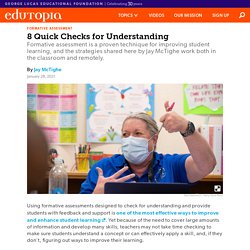
Yet because of the need to cover large amounts of information and develop many skills, teachers may not take time checking to make sure students understand a concept or can effectively apply a skill, and, if they don’t, figuring out ways to improve their learning. Thankfully, there are practical, proven formative assessment techniques that teachers can use as a quick “pulse check” to gauge students’ understanding.
The eight techniques here can be applied across grades and subject areas in virtual, hybrid, and in-person learning environments. The results of these checks should not be graded since the purpose of formative assessment techniques is to obtain feedback to use in improving teaching and learning, not to evaluate learning. 1. Thumbs up: I understand _____ and can explain it in my own words. Video. 7 Tips for Breakout Room Success in Middle and High School. Whether you use Zoom, Google Meet, or Microsoft Teams, having students in shared small groups can foster a deeper level of connection and communication, but depending on your class, the age of the students, and the content, it can be a scary moment to release control and trust the space.
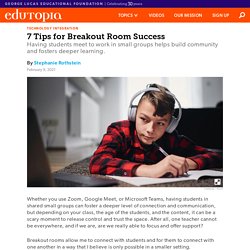
After all, one teacher cannot be everywhere, and if we are, are we really able to focus and offer support? Breakout rooms allow me to connect with students and for them to connect with one another in a way that I believe is only possible in a smaller setting. 7 Tips for Creating and Maintaining Successful Breakout Spaces 1. Short and sweet. 2. 3. Guia Practica PM4R Agile. Conocimientos previos. Bb Collaborate. Inicio. 9 Trivias de Google Earth para motivar tus clases de Historia y de Ciencias – Pedagogía Tic. Echalo A Suerte. Global EdTech 50.
Among the 50 companies listed above, Chinese-based growth education companies continue to showcase their dominance from the past years with 16 companies from the region.

The majority of these platforms are epitomes of Weapons of Mass Instruction, with platforms like Yuanfudao, Zuoyebang, and Ximalaya reaching hundreds of millions of learners each, and the 16 companies above reaching an aggregate of 1.3 billion learners. Yuanfudao and Zuoyebang also had two mega-rounds this year, raising $1.75B in total. While K-12 online tutoring and English Language Learning (ELL) have continued to be the two largest categories for startups, other areas such as programming and math (e.g., Codemao, VIPThink), online higher ed (e.g., Kaikeba), and in-classroom tools (e.g., Classin, Squirrel AI) have been growing rapidly. The US is also heavily represented on this list with 17 companies headquartered in the United States. Habilmind CDD - The Difference Between Emergency Remote Teaching and Online Learning. Well-planned online learning experiences are meaningfully different from courses offered online in response to a crisis or disaster.
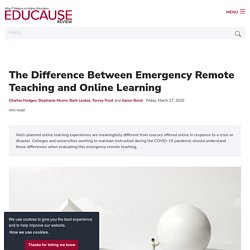
Colleges and universities working to maintain instruction during the COVID-19 pandemic should understand those differences when evaluating this emergency remote teaching. Due to the threat of COVID-19, colleges and universities are facing decisions about how to continue teaching and learning while keeping their faculty, staff, and students safe from a public health emergency that is moving fast and not well understood. Many institutions have opted to cancel all face-to-face classes, including labs and other learning experiences, and have mandated that faculty move their courses online to help prevent the spread of the virus that causes COVID-19. The list of institutions of higher education making this decision has been growing each day. The temptation to compare online learning to face-to-face instruction in these circumstances will be great. Table 1. M. Webinar IEEE AENUI.
¿Educación a Distancia o Aprendizaje Digital? Interesante artículo a cargo de Sandro Marcone, ahora ex funcionario del MINEDU donde señala que hasta el viernes 13 de marzo se contaban 10.5 millones de peruanos que habían iniciado, o estaban por empezar, sus estudios en algún nivel educativo.
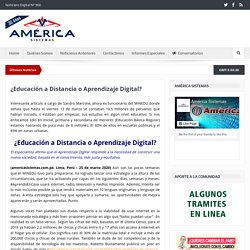
Si nos enfocamos solo en inicial, primaria y secundaria de menores (Educación Básica Regular) estamos hablando de poco más de 8 millones. El 60% de ellos en escuelas públicas y el 85% en zonas urbanas. El especialista afirma que el Aprendizaje Digital responde a la necesidad de construir una nueva sociedad, basada en el conocimiento, más justa y equitativa. (americasistemas.com.pe. Aprender en red y en la red – La red, el aprendizaje y otras cosas más.
Hace un par de meses, escribí un breve texto sobre el aprendizaje en red y en la red para el equipo del Centro de Aprendizaje en Red del ITESO (que por cierto me doy cuenta que no tenemos aún nuestro sitio web).

El texto lo coloqué en un documento compartido y durante este tiempo lo hemos ido modificando, los del equipo del CAR y otros buenos amigos que nos han ayudado con sus colaboraciones. Sabemos que el documento que ha quedado aún está en proceso; sin embargo vimos conveniente comenzar a trabajar con la perspectiva que en él se muestra. Lo reproduzco a continuación: Aprendizaje en red es un significado emergente. Er.educause. This article proposes six models of blended online course delivery, ranging from a highly supported faculty-guided model to an independent self-paced model.
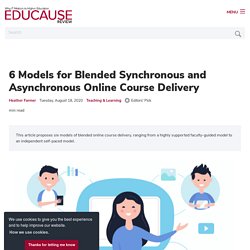
Current definitions of blended learning typically acknowledge movement between face-to-face and online course delivery.1 In their article about blended learning, D. Home learning. Aprendemos en casa - RTVE.es. Educative Innoveision. No hay nada peor que ponerse uno a escribir un libro sobre educación cuando, lo único que tiene claro, es que va a ser algo incoherente.

Todos tenemos claro que se escriben libros sobre el tema por encima de nuestras posibilidades y que, en un modelo de negocio en el que se ha convertido gran parte de lo que, supuestamente, habría de ser mejora educativa, cada vez es más habitual encontrarnos con cientos de libros, la mayoría de dudosa calidad (sí, como éste si tenéis ganas de leerlo) que reflejan la falta de ideas o lo necesario que supone escribir por encima de cualquier otro objetivo. Es muy fácil distribuir un producto que acaba sirviendo para que uno se fotografíe con el mismo y lo suba a las redes sociales para fardar con sus amiguetes de su gran afición a la profesión.
También sirve para descubrir que uno tiene la necesidad de devorar todo lo que huela a educación. La pedagogía es inexistente en cada uno de los capítulos que conforman este libro. PLE - entorno personal de aprendizaje. Individual Excercises con zoom. MI PLE por Jennifer Nino en Genially. Best Tools for Virtual and Distance Learning.
Guía para la enseñanza y el aprendizaje online. 15 tips para ser un buen estudiante virtual. Home » Blog » 15 tips para ser un buen estudiante virtual.
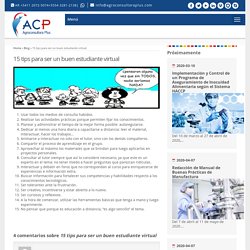
Recursos sobre teletrabajo y aprendizaje a distancia. Querida Comunidad,
